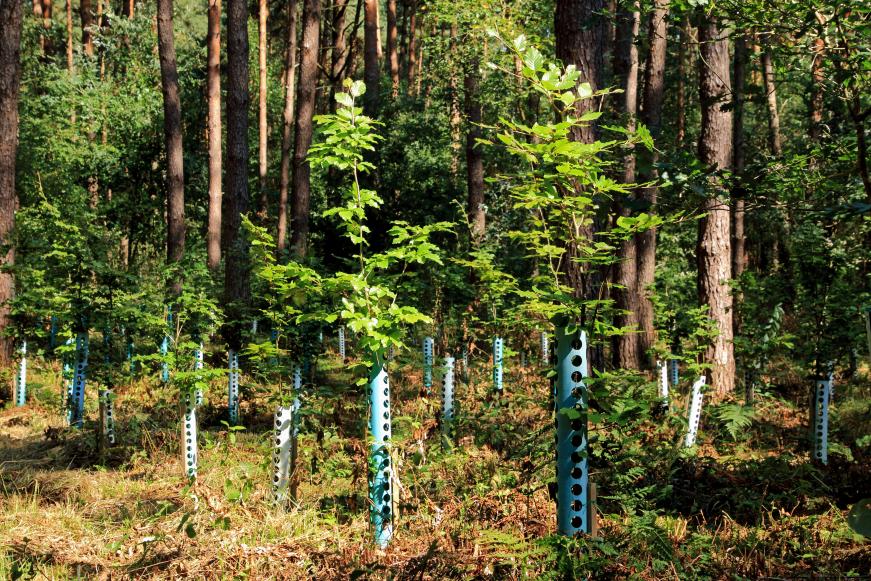Titel
Researching ways to remove CO2 responsibly

It has been official since August 2021. With the amendment to the Climate Protection Act, the German government has determined that by 2045, Germany is to be climate neutral in order to limit the effects of anthropogenic climate change. The law even states that "negative emissions" are to be achieved from the middle of the century, i.e. that more CO2 is bound than emitted. Scientists agree that this goal cannot be achieved without actively removing CO2 from the atmosphere.
There will always be residual emissions of greenhouse gases that can hardly be avoided for physical, chemical or even economic reasons – for example in agriculture, industry or waste management. The Sixth Assessment Report on "Mitigation of Climate Change" of the International Panel on Climate Change (IPCC) confirms that negative emissions are needed to limit global warming to 1.5 °C or 2 °C. All climate scenarios for limiting temperature rise to avoid catastrophic impacts of climate change assume the use of CDR. Moreover, CDR could serve as a kind of emergency anchor in case the temperature rise exceeds the set targets. Soberly considered, the situation is as follows. Even if all pledges of the international community for emission reductions are met, the target of 1.5 °C will be clearly exceeded. In this case, large amounts of negative emissions would be necessary in order – according to theory – to subsequently lower the global mean temperature again.

Climate neutrality requires massive CO2 removal
According to the climate scenarios, we are talking about up to several hundred billion tonnes of CO2 by 2100, which corresponds to a multiple of today's annual global emissions (approx. 40 billion tonnes of CO2 per year). These figures give an idea of the scale of the undertaking. To achieve such orders of magnitude in CDR, very extensive capacities and infrastructures are needed. For all CDR methods, it is therefore also necessary to assess where the physical, ecological or societal limits of their application lie. Since critical side effects are also expected for ecosystems, societies or the economy through these countermeasures to climate change, the view has to be broadened. Research must not be limited to pure technology development. DLR-PT already recognised the importance of this topic early on. As early as ten years ago, we designed and accompanied a broad-based exploratory study on the complex of "climate engineering" for the Federal Ministry of Education and Research (BMBF). Subsequently, the topic became the subject of a DFG priority programme. Since then, as DLR-PT, we have been observing the worldwide scientific and political development of CDR, advising the BMBF and other Federal ministries on this basis and supporting them in parliamentary debates on this challenging and sometimes controversial topic.
Carbon Dioxide Removal encompasses approaches and methods for removing CO2 from the atmosphere and then storing it permanently in underground geological formations, in biomass, oceanic reservoirs or long-lived products in order to achieve negative emissions.
CDRterra – a new BMBF funding programme on CDR
Out of this debate, in 2020, we developed the funding programme "Methods for the Extraction of Atmospheric CO2" – called CDRterra – for the BMBF. Over the next three years, ten interdisciplinary research networks with more than 100 participating researchers will investigate CDR methods on land in an open-ended and holistic manner. All projects will address the question of the realistic CO2 removal potential and the permanent binding of CO2.
Conflicting goals, interactions and synergies with other sustainability goals will also be examined. CDR methods can, for example, change the use of large areas of land. This can have negative impacts on biodiversity and lead to competition with other land uses, such as food production. Large-scale interventions in natural systems usually also mean changes in the Earth's water and radiation balance. The funding programme brings together individual strands of knowledge and creates a sound knowledge base on the institutional, economic, social and political framework conditions of CO2 removal.
Discussing a controversial topic with an open mind
The topic is to be discussed and analysed with the involvement of the public and civil society. Ultimately, two aspects are at stake: a well-founded knowledge base for the use of CDR and science-based recommendations for a responsible, political shaping of this future field. It is crucial to set sufficient incentives for implementation and at the same time to prevent undesirable developments. Finally, CDR methods are by no means uncontroversial. We are not talking about drastic measures such as intervening in the Earth's radiation budget by reducing incoming solar radiation (Solar Radiation Management, SRM). Such methods are difficult to control and meet with fierce public opposition. However, CDR approaches are also rejected by some critics. Efforts to achieve ambitious climate protection, they fear, could slacken if there is a prospect of CO2 emissions being removed at a later date. At the same time, it is absolutely clear that CDR can in no way be a substitute for the greatest possible, rapid reduction of emissions. It would be reckless to rely on it, because we do not yet know enough about the feasibility and effects of a massive, large-scale deployment of CDR methods. There is every argument for avoiding their necessity as much as possible and for reducing greenhouse gas emissions as extensively and quickly as possible. However, without CDR, we are likely to miss the climate targets we have set ourselves.
Answering questions of ethics and acceptance
We are therefore certain that well-funded, transparent, public research funding and an open debate on CO2 removal methods are needed. If these methods are to be massively expanded, this will only succeed with broad support and acceptance from the public. The BMBF has formulated a corresponding claim for the projects in the funding programme. None of these projects is limited to technological feasibility alone. All are interdisciplinary in nature and also integrate political, ethical, economic and social science analyses. They will conduct a broad social discourse on CDR in a participatory manner with stakeholders and bring their findings to the public. After many years of building up expertise on CDR, we are very familiar with the debates and actors in the international research landscape. The combination of technological, natural science, social science and humanities expertise with sound insight into climate policy reality is another building block for the interdisciplinary and comprehensive quality of our advice.
We are committed to using solid research results to lay the groundwork for necessary political decisions on with which CDR method portfolio and under which societal, economic and political conditions the greatest CO2 removal and storage potential can be achieved. And it must not be forgotten that where methods prove to be promising, economically and socially viable, there are also market potentials and export opportunities for the German economy. Developing a knowledge advantage in an international comparison is therefore worthwhile. And that is what we, DLR-PT, are working on.
Collapse Title
Nature-based CDR methods

- Targeted afforestation and reforestation increase CO2 uptake by plants. At the same time, existing forests must be protected from drought, pests and fires so that these "natural CO2 sinks" do not become "sources".
- Agroforestry is a form of land use that combines crop cultivation, trees and sometimes livestock in one area. By linking arable land, forest, meadows and pastures, CO2 uptake in plants can be increased and biodiversity promoted at the same time.
- Drained peatlands release large amounts of CO2. The rewetting of peatland soils could eliminate this CO2 source. In waterlogged peatlands, plant remains are not completely decomposed in the absence of oxygen; the carbon bound in the plants is conserved and converted into carbon-rich peat in the long term.
Collapse Title
Technical CDR methods

- DAC (Direct Air Capture) plants separate CO2 directly from the ambient air by means of large filters. The CO2 can then be converted into solid or liquid substances and stored permanently (Direct Air Carbon Capture and Storage, DACCS).
Collapse Title
Hybrid CDR methods that contain nature-based and technical elements

- With the BECCS (Bioenergy with Carbon Capture and Storage) CDR method, energy crops are grown. Burning the plants produces (bio)energy and CO2, which is captured and permanently stored.
- Pyrolytic carbonisation of plants or biowaste produces biochar. When introduced into arable soils, the CO2 bound in the biochar is permanently fixed. At the same time, the biochar can improve the water and nutrient storage capacity of the soil.
- CO2 is bound by the weathering of silicate or carbonate rock. This process can be accelerated by applying rock flour to arable soils.